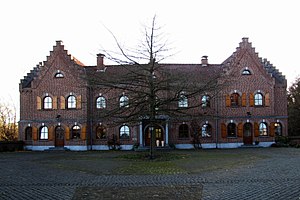Lambertz Mill
| Lambertz Mill
|
||
|---|---|---|
|
The Lambertz Mill was once where this house stands |
||
| Location and history | ||
|
|
||
| Coordinates | 51 ° 0 '52 " N , 6 ° 10' 27" E | |
| Location | Germany | |
| Waters | worm | |
| Built | before 1534 | |
| Shut down | around 1990 | |
| technology | ||
| use | Walk - bone and fruit grinder | |
| Grinder | 1 grind | |
| drive | 1 water wheel | |
| water wheel | undershot | |
The Lambertz mill was a watermill on the Junge Wurm in the city of Heinsberg in the North Rhine-Westphalian district of Heinsberg in the administrative district of Cologne .
geography
The Lambertz mill had its location on the boys worm , on the field road in the district Randerath in town Heinsberg. The property on which the mill building stood is approx. 54 m above sea level . The mill was only about 1000 m away from the junction with the Alte Wurm . A mill pond was in front of it . The Brünkers mill was located below .
Waters
The Junge Wurm was a body of water that ran more or less parallel to the Wurm . The junction from the Wurm was in Nirm, a district of the city of Geilenkirchen . Here the worm has a height of 54 m above sea level. The river Junge Wurm, also known as the Kleine Wurm , flowed in a north-northwest direction via Randerath , Horst , Porselen , Dremmen , Grebben , Heinsberg , Kempen and Karken across the German - Dutch border towards Vlodrop and empties at an altitude of 29 m above sea level on Dutch territory into the Rur . It was a natural body of water in which humans had a hand in many places. The Junge Wurm was connected to the Heinsberg moat , the mill canal, the Liecker brook and the mill brook . This composite body of water served for surface drainage and the benefit of the people. For centuries there were around 15 water mills on the Junge Wurm, with a slope of 26 m between Randerath and Karken. With the worm straightening in the 1960s and 1970s, the young worm disappeared from the maps . Instead, drainage channels and trenches were created. The water association Eifel-Rur (WVER) is responsible for the care and maintenance of the water body with a catchment area of 355.518 km 2 .
history
The Lambertz mill, which stood in front of the city wall in front of the field gate, was also called the full mill . It was first mentioned in the Reformation in 1534/35 . At that time, the mill was also used as a place of prayer, where the preachers spread the gospel . In 1624, religious services for Reformed believers were held in the mill . In 1838 the fulling mill was converted into a bone mill , which later became an oil brawler . From 1882 the mill served as a grinding mill , which was equipped with a 25 HP water turbine instead of the water wheel . The mill operation was stopped in 1960. In the 1990s the mill was shut down and a new house was built.
gallery
Randerath on the tranchot card 1805/1807
literature
- Hans Vogt: Lower Rhine water mill guide 2nd edition. Verein Niederrhein, Krefeld 1998, ISBN 3-00-002906-0 , pages 304.
- Ms. Haubrock: The mills of the former Randerath office, home calendar of the Selfkant district Geilenkirchen-Heinsberg 1961, pages 25–29.
→ See also the list of mills on the Wurm
Web links
Individual evidence
- ^ German basic map 1: 5000
- ↑ Topographical Information Management, Cologne District Government, Department GEObasis NRW ( Notes )
- ↑ Archived copy ( memento of the original from October 17, 2013 in the Internet Archive ) Info: The archive link was inserted automatically and has not yet been checked. Please check the original and archive link according to the instructions and then remove this notice.
- ↑ http://www.wver.de/





